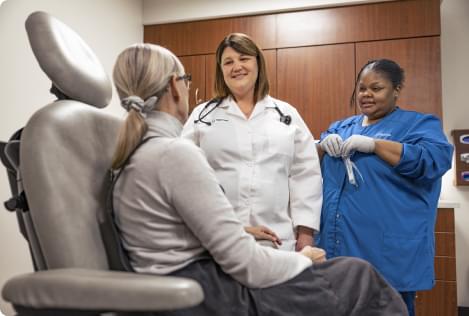Overview
Common warts are small, grainy skin growths that occur most often on the fingers or hands. They're rough to the touch and often have tiny black dots. These dots are clotted blood vessels.
Common warts are caused by a virus and are transmitted by touch. It can take 2 to 6 months for a wart to develop. The warts are usually harmless and over time go away on their own. But many people choose to remove them because they find them bothersome or embarrassing.

Symptoms
Common warts symptoms include:
- Small, fleshy, grainy bumps on the fingers or hands.
- Feeling rough to the touch.
- A sprinkling of black dots, which are clotted blood vessels.
When to see a doctor
See a healthcare professional for common warts if:
- The growths hurt, bleed, burn or itch.
- You've tried treating the warts, but they persist, spread or come back.
- The growths are bothersome or interfere with activities.
- You're unsure whether the growths are warts.
- You have many warts.
- You have a weak immune system.
- Warts show up on the face, feet or genitals.
Causes
Common warts are caused by the human papillomavirus, also called HPV. There are more than 100 types of this common virus, but only a few cause warts on the hands. Some strains of HPV are spread through sexual contact. But most are spread by casual skin contact or shared objects, such as towels or washcloths. The virus usually spreads through breaks in the skin, such as hangnails or scrapes. Biting your nails also can cause warts to spread on your fingertips and around your nails.
Each person's immune system responds to HPV differently. So not everyone who comes in contact with HPV develops warts.
Risk factors
People at higher risk of developing common warts include:
- Children and young adults.
- People with weakened immune systems, such as those with HIV/AIDS or those who have had organ transplants.
- People with the habit of nail biting or picking at hangnails.
Prevention
To help prevent common warts:
- Don't touch or pick at warts, including your own.
- Don't use the same emery board, pumice stone or nail clipper on your warts as you use on healthy skin and nails. Use a disposable emery board.
- Don't bite your fingernails or pick at hangnails.
- Groom with care. And avoid brushing, clipping or shaving areas that have warts.
- Avoid shared hot tubs, showers and warm baths. And don't share washcloths or towels.
- Use hand moisturizer daily. This helps prevent dry, cracked skin.
Diagnosis
In most cases, a healthcare professional can diagnose a common wart with one or more of these techniques:
- Examining the wart.
- Scraping off the top layer of the wart to check for dark, pinpoint dots, which are common in warts.
- Removing a small sample of the wart and sending it to a laboratory to rule out other types of skin growths. This is called a shave biopsy.
Treatment
Most common warts go away without treatment, though it may take a year or two and new ones may develop nearby. Some people choose to have their warts treated by a healthcare professional because home treatment isn't working and the warts are bothersome, spreading or a cosmetic concern.
The goals of treatment are to destroy the wart, stimulate an immune system response to fight the virus or both. Treatment may take weeks or months. Even if warts clear up with treatment, they tend to come back or spread. Your healthcare professional will likely suggest starting treatment with the least painful method, particularly when treating young children.
Treatment for common warts includes the following approaches. Which is best for you depends on the where the wart is, your symptoms and your preferences. These methods are sometimes combined with home treatments.
- Prescription-strength peeling medicine. Wart medicines with salicylic acid work by removing layers of a wart a little bit at a time. Studies show that salicylic acid is more effective when combined with freezing or pulsed-dye laser treatment.
- 5-fluoruracil. This wart medicine is applied directly to the wart and keep under a bandage for 12 weeks. This method is often used with good results in children.
- Candida antigen. This method works by injecting candida antigen into a wart. It stimulates the immune system to fight warts, even those not close to the injection site. This is an off-label use of this medicine, which means that it doesn't have FDA approval for removing warts. This method is often used with good results for people whose warts haven't responded to other treatments.
-
Freezing. Freezing therapy administered at the office of a healthcare professional involves applying liquid nitrogen to a wart. This method also is called cryotherapy. It works by causing a blister to form under and around the wart, killing the tissue. The dead tissue sloughs off in a week or so. You'll likely need repeat treatments.
Side effects of cryotherapy include pain, blistering and scarring. Because this technique can be painful, it usually isn't used to treat the warts of young children.
-
Other acids. If salicylic acid or freezing isn't working, your healthcare professional might suggest trichloroacetic acid or other acids. With this method, the wart is shaved and then the acid is applied with a wooden toothpick. You'll need repeat treatments every week or so until the wart goes away.
Side effects are burning, stinging and changes in skin color.
- Remove wart tissue. Your healthcare professional can use a special tool to remove part of the wart. This tool is called a curet. This treatment may be combined with other methods. The wart may return in the same area.
-
Laser treatment. If other methods haven't worked, your healthcare professional might suggest laser treatment. This type of treatment is also called photo-based therapy. Examples include carbon dioxide laser, pulsed-dye laser and photodynamic therapy. Laser treatment burns the tiny blood vessels in warts. Over time the wart dies and falls off.
Evidence for how well laser treatments work is limited.
A carbon dioxide laser can cause pain and scarring.
Self care
Home treatments such as the following often remove common warts. Do not use these methods if you have an impaired immune system or diabetes.
-
Peeling medicine. Nonprescription wart removal products such as salicylic acid are available as pads, gels and liquids. For common warts, look for a 17% salicylic acid solution. These products (Compound W, Dr. Scholl's Clear Away, others) are used daily, often for a few weeks. For best results, soak your wart in warm water for a few minutes before applying the product. File away any dead skin with a disposable emery board or a pumice stone between treatments.
If your skin becomes sore, stop using the product for a while. If you're pregnant, talk with your doctor before using an acid solution.
- Freezing. Some liquid nitrogen products are available in nonprescription liquid or spray form (Compound W Freeze Off, Dr. Scholl's Freeze Away, others).
- Duct tape. Results from several small studies of duct tape for warts show that this treatment doesn't work very well. If you'd like to try it, take these steps: Cover the wart with duct tape for six days. Then soak the wart in water and gently remove dead tissue with a pumice stone or disposable emery board. Leave the wart exposed for about 12 hours, and then repeat the process until the wart is gone.
Preparing for an appointment
You'll likely start by seeing your primary healthcare professional. But you may be referred to a specialist in disorders of the skin. This type of doctor is called a dermatologist. The following tips can help you prepare for your appointment.
What you can do
Bring a list of all medicines you take regularly — including nonprescription medicines and dietary supplements. List the daily dosage of each.
You also may want to list questions to ask during your appointment, such as:
- What made the warts develop?
- If I have them removed, will they come back?
- What types of treatments are available to remove the warts, and which do you recommend?
- What types of side effects can I expect?
- What are the alternatives to the approach you suggest?
- If the growths aren't warts, what tests do you need to do?
- How can I prevent warts?
What to expect from your doctor
Your healthcare professional may have some questions for you, such as:
- When did you first notice the warts?
- Have you ever had them in the past?
- Are you bothered by the warts, either for cosmetic reasons or for comfort?
- What treatments have you already used for your warts? How long have you used them and what were the results?
© 1998-2024 Mayo Foundation for Medical Education and Research (MFMER). All rights reserved. Terms of Use


